Speech therapy goals for expressive language can be tricky at times, but I’m here to share my best goal-writing and implementation tips. I find it easiest to have a few good core goals ready to go that I can then individualize depending on the student and their needs. Keeping a steady log of these goals makes IEP goal writing so much easier.
To gain access to my IEP goal bank and some of my other favorite freebies, sign up below!
Expressive Language
“Language is a rule-governed behavior. It is defined as the comprehension and/or use of a spoken (i.e., listening and speaking), written (i.e., reading and writing), and/or other communication symbol system (e.g., American Sign Language).” (ASHA).
Language can be broken into 2 main areas, receptive and expressive. Receptive refers to listening and reading skills and expressive language refers to speaking and writing.
Speaking includes the following skill areas: appropriate use of phonological patterns, using morphemes correctly, using correct sentence structure, expressive vocabulary, and social language.
Writing included the following skill areas: spelling, grammar and sentence structure, writing vocabulary, and point of view or intended message/purpose.
What is an Expressive Language Disorder?
An expressive language disorder is present when someone has difficulty with sharing their thoughts, ideas, and feelings; or they have difficulty using words in spoken and/or written language.
How to Write Speech Therapy Goals
Goals should be written to be specific, measurable, attainable, relevant, and time-based. Let’s break some of these down.
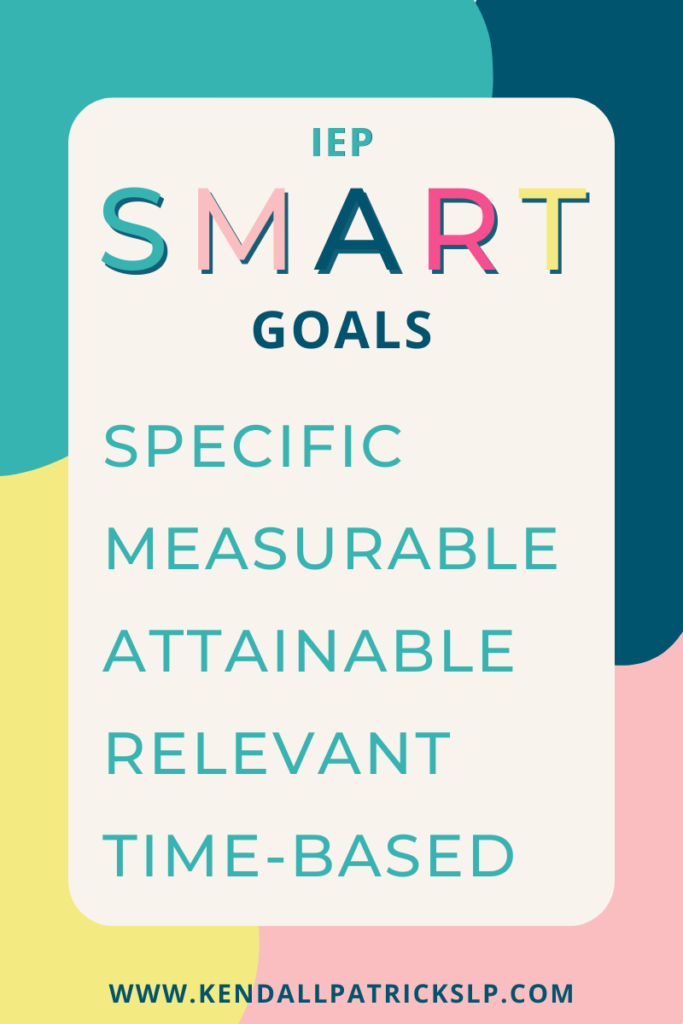
Specific – your IEP goals should be specific and define exactly what you were wanting to be accomplished. They should also specify who will accomplish it and what steps will be taken to accomplish it.
Measurable – your IEP goal should be measurable so that you can track progress and easily be able to tell when they are mastered.
Attainable – your IEP goal should be attainable. This means it’s a goal that the student can meet within a reasonable amount of time. This is typically within the school year or one calendar year. And remember it should be specific to the student. So if that student’s accuracy is currently at 0% an attainable goal for them may be 50 to 60%, not 80.
Relevant – your IEP goal should be related to the big picture. Ask yourself what you are trying to accomplish or what you want the student to accomplish with this goal. Whether it’s gaining access to grade-level material in the classroom or building the foundational skills they need in order to gain those age-appropriate skills. Make sure it is relevant to that student’s specific means, not just based on a norm-referenced test item.
Time-based – last but not least make sure your IEP goal is time-based. Have a date and time in which the goal is expected to be mastered. This could be by the end of the school year, by the next grade level, or by the IEP expiration date.
Goals for Expressive Language
One thing I struggled with the most when I was starting out my first year was quickly and easily writing new IEP goals or updating old goals for students on my caseload. I tended to overthink and write and rewrite my goals until they were just right for my students. I made it so hard on myself. For more on my journey as a school SLP, click here.
Now 10 years in, I have created a goal bank for myself. It includes ideas in my head as well as on paper. These are my go-to starting points when writing an IEP. These basic goals give me a good starting point. When writing my IEPs, all I have to do is go in and individualize based on that student’s needs. Now, is absolutely everything included here? No. Will there always be outliers or students with totally different needs? Absolutely. After all, this is the schools and we just never know what each year will bring. However, we can be pretty sure we’ll need a couple of key goals in the main areas we see year after year.
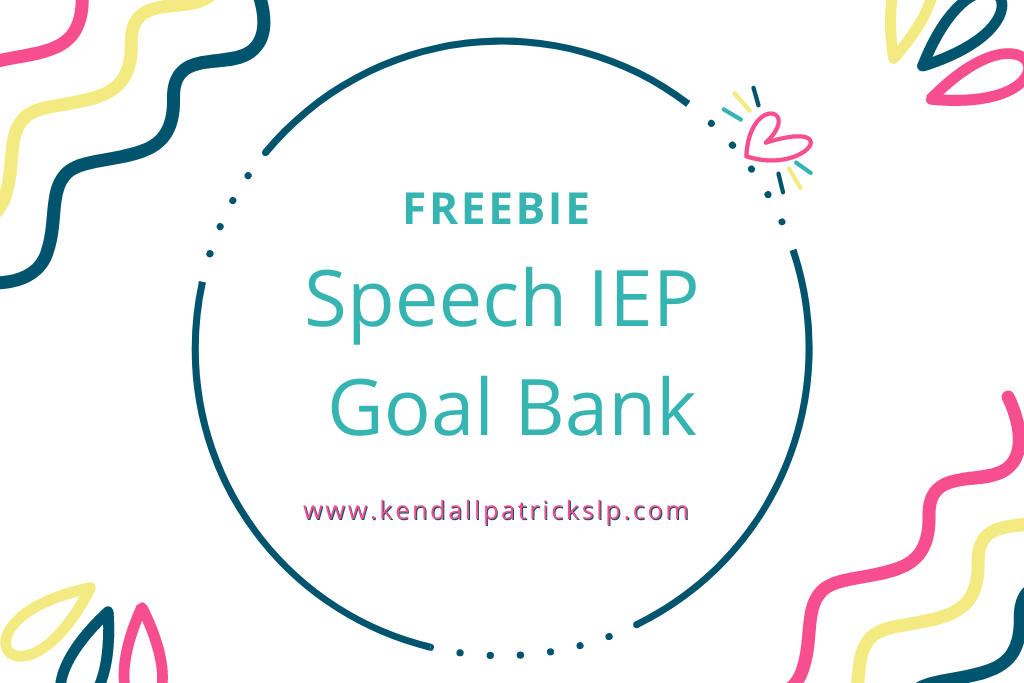
Speech Therapy Goals for Expressive Language Delay
Here is a general outline for some SMART goals:
- By the end of this IEP cycle, STUDENT will ________ in structured therapy tasks with ____% accuracy with visual cues only, as measured by therapy data and observations.
- By the end of this IEP cycle, STUDENT will apply _______ strategies in structured speaking tasks (e.g., answering questions, describing, story retell) in _____ out of 5 attempts independently as measured by therapy data and observations.
Expressive Language Goals for Kindergarten and Early Elementary
A lot of us write and work on “wh” question goals in therapy quite frequently. One mistake I see a lot when reading these goals is that they are too open-ended and not specific enough. There are so many different types of “wh” questions as well as ways to teach them. I like to initially write my goals to work on one or two types (e.g., “who” and “what” as they are earlier to develop) in the context of a thematic unit. So specifically teaching types of answers to who and what questions and the vocabulary needed.
Then I move on to where, when, why, and how questions. These are more complex and can have different types of answers as well. For example, “where” answers can be specific locations (e.g., Florida, grocery store) or prepositional phrases (e.g., under the chair). How questions are typically the most complex and include other needed language skills as well. Skills such as describing (e.g., “How does it feel?”) or sequencing (e.g., “How do you build a snowman?”).
Here is an example of a basic “wh” question goal:
- During structured therapy tasks, STUDENT will answer “who” and “what” questions related to a thematic unit with 80% accuracy as measured by therapy data and observations.
For expressive vocabulary goals, I might write something like this:
- During structured therapy tasks, STUDENT will express word relationships (e.g., categories, functions, similarities, differences), given a sentence starter, with 75% accuracy as measured by therapy data and progress monitoring.
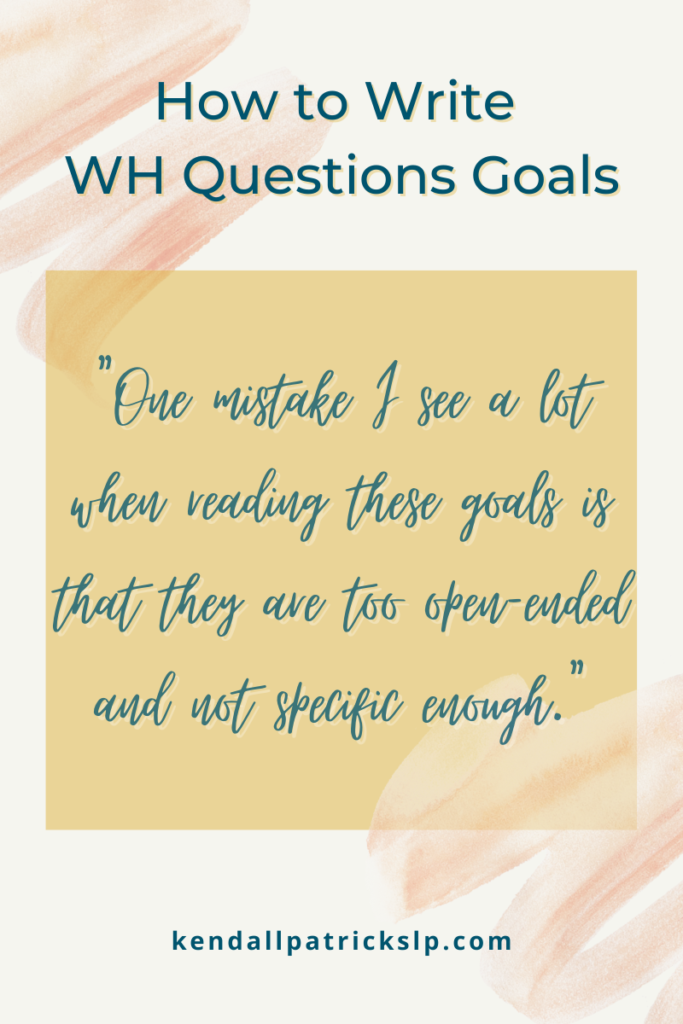
Expressive Language Goals for Upper Elementary
When writing vocabulary goals, I like to focus on the implementation and use of strategies instead of just focusing on learning new vocabulary words. I feel it is more important that the students we work with learn strategies. Strategies that they can apply to any material and any new vocabulary word instead of just memorizing words that they’ll probably forget later on.
Here is an example of how I write some of my goals:
- During structured therapy tasks, STUDENT will apply an organizational strategy to provide 3 to 4 details when defining/describing presented vocabulary as measured by therapy data, student product, and/or progress monitoring.
Another way I work on and write goals for “wh” questions is in relation to an orally read story. I typically work on these skills within a unit to address story narrative goals as well.
Here are some examples of these types of “wh” questions and a general retell goal:
- During structured therapy tasks, STUDENT will answer “where” and “when” questions related to an orally presented story with 80% accuracy as measured by therapy data and observations.
- STUDENT will apply an organizational strategy to express 3-4 story grammar parts (e.g., character, setting, problem, ending) following an orally presented story in 3 out of 4 attempts as measured by therapy data and progress monitoring.
Speech Therapy Activities for Expressive Language
Now that you’ve written your goals for expressive language, it’s time to plan your expressive language activities to go with them. There are so many options for activities to develop expressive language skills, these are some of my go-to ones. When it is time to write new goals, the first thing to do is get a baseline. When it is time to update old goals, make sure you have a recent progress monitoring point.
Language Baselines – Get the Most Bang for Your Buck!
One of the best ways to gather a variety of baseline data in a simple measure is to get a narrative retell sample. During the first couple weeks of my back-to-school speech therapy sessions, I spend one day getting narrative samples from all of my students identified with a language delay or disorder. What does this look like? You may ask… or Who’s got time for that?? It’s not as daunting a task as it seems, I promise!

This is what I do:
Step 1: Choose a book with a clear complete episode (or multiple episodes). This includes a character, setting, initiating event/problem, feelings, action sequence, consequence, solution, and ending. (For speech therapy activities for older students, you can also look at higher-level components such as dialogue, embedded episodes, inferences, etc.).
Step 2: Read this book to each of your groups for the day (without additional questioning, prompting, or guiding). That is so hard, I know! Let them know you will be asking them to tell you the same story at the end. So they need to listen closely.
Step 3: After finishing the story, pull each student aside and ask them to tell the story back to you as well as they can. Do not prompt them. Encourage them to do their best while reminding them it is okay if they do not remember everything.
Step 4: Write down everything they say. Make sure to write it exactly as they have said it so you can mark grammar errors as needed.
Step 5: Review responses and mark the components the student has included and the ones they have left out. Also, mark any grammatical errors and any transition words that they used.
And that’s it!
In one therapy session (with a little review time afterward) you have an overall picture of your student’s language content – vocabulary, sentence structure, and grammar. This should give you a place to start for the year in therapy based on the language components that were left out (e.g., character names, feeling words, correctly sequenced actions, etc.), weak or repetitive vocabulary, and a variety of sentence structure (e.g., correct grammar use, past tense verb use, pronoun use, transition words, complex structure, etc.) or lack thereof.
Another must in my early back-to-school speech therapy sessions is a vocabulary baseline measure. We all have loads of speech therapy vocabulary activities, but how well are we collecting data and measuring growth as we are teaching these vocabulary skills?
This is how I do it:
Baseline Measure: Ask the student to describe 3 items in a variety of categories (e.g., cat, banana, bus; lion, chair, airplane, etc.) and write their response. I mark their responses based on the variety of details they give (e.g., category, describing words, location, parts of a whole, composition, function) and score out of a possible 6 attributes. Note: even if they name 7 parts, I give one point as it is just to mark that they included this type of attribute. This is based on the vocabulary hierarchy and how we develop language. I have found that typically, my students with a language delay often provide a function (and sometimes a part) or multiple words in these areas but no other attributes as they have not yet developed these skills.
This measure gives me an excellent place to start in therapy when focusing on vocabulary interventions. I address teaching the different attributes (e.g., category activities, work on adjectives) as well as how to include the variety of attributes as a whole. In my district, we all have access to an Expanding Expression Tool by Sara Smith (which I LOVE and use all the time) but you can use a variety of activities to address these skills. Side Note: If you ever have the opportunity to attend one of Sara’s presentations and/or purchase her kit, do it! She is amazing and has so many great ideas for therapy with the research to back it up.
I then use the same 3 words to progress monitor students in order to mark progress and update goals when needed.
Wordless Picture Books for Speech Therapy Goals for Expressive Language
I love using wordless picture books to work on describing and narrative retell. Because you are not stuck to one storyline or one main character, you can work on multiple different storylines and take your therapy targets in any direction. These are some things I might target with a wordless book:
- Character description (use visual strategies and/or graphic organizers)
- Setting description (use visual strategies and/or graphic organizers)
- Sequenced events – use the pictures to guide the story, have a student make it up, generate a story together, or you tell the story and have students retell it using the pictures
- Transition words
- Feeling words – use facial features to describe how they may be feeling
- Predicting
- Drawing conclusions
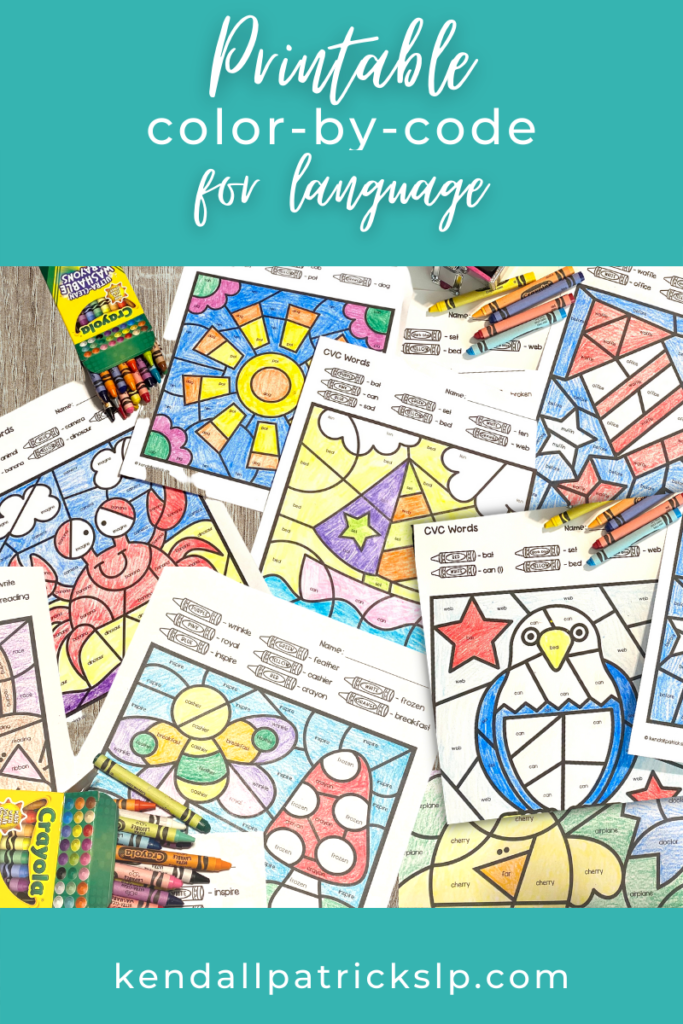
Coloring Pages Speech Therapy Goals for Expressive Language
My kids love to color so I developed these color-by-code language sheets that can be used in mixed groups or any therapy session to target a variety of goals. They come in many different themes and I am creating new ones all the time. Check out my articulation color by code sheets while you’re over in my store too!
For more speech therapy goals for expressive language ideas:
Goal Bank from The Speech Express
Expressive Language & Written Language Delays from Talk SLP LLC
Middle School Language Goals from Inventive SLP
Sources:
https://www.asha.org/practice-portal/clinical-topics/spoken-language-disorders/language-in-brief/
https://www.asha.org/public/speech/development/speech-and-language/
Don’t forget to sign up with your email address here to get access to my free library (growing all the time) full of some of my goodies made exclusively for my followers.
I hope you found some of these ideas helpful and can use one or more in your therapy room. Please leave a comment or shoot me an email if you want to share some of your favorite speech therapy goals for expressive language.

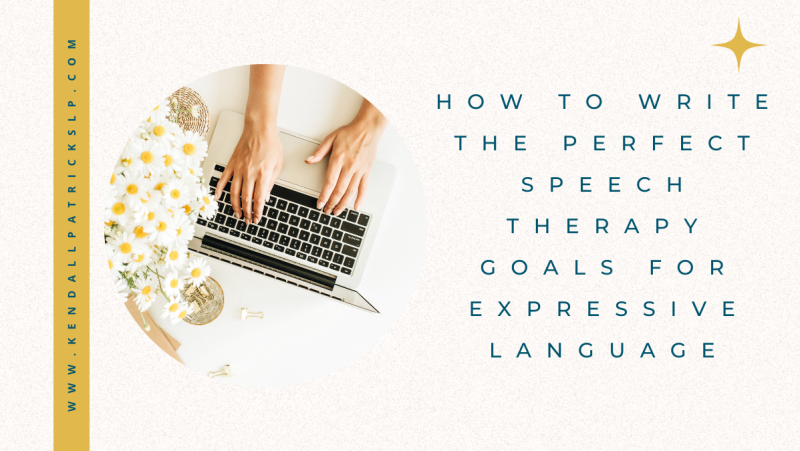

One Response